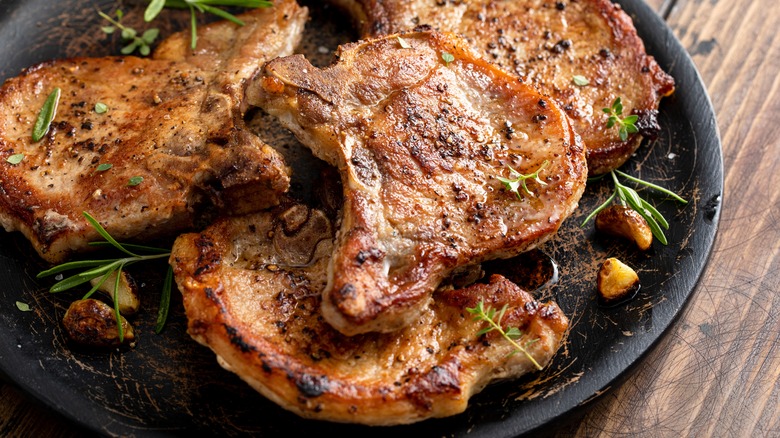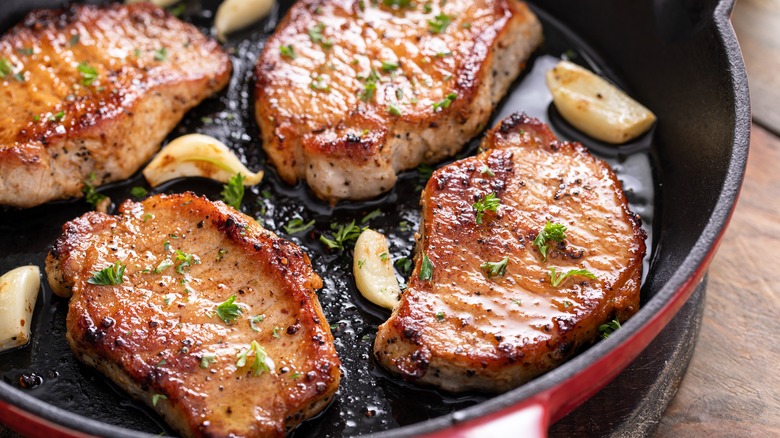The Searing Tip To Follow For Perfectly Browned Pork Chops
If you've ever had to moisten pork chops with a pan sauce or eaten a family dinner of pork chops covered in applesauce as a kid, you may wonder what's so special about them on their own. How do you find the perfect balance, avoiding drastically undercooking them or preventing that dry, unpleasant toughness when overcooked? Like other cuts of meat, the ideal finish is an evenly browned exterior with a moist, flavorful interior. And for pork chops, the key to perfect browning lies in the fat.
Many standard store-bought pork chops will have a layer of fat around the edges. This fat is chewy and rubbery and, at first glance, not enjoyable to eat, so it's often trimmed or completely removed before cooking. But instead of discarding it, next time, try leaving the fat on the pork chop and turning it into something irresistible. By simply turning the pork chop on its fat-rimmed side in the pan, that strip of fat renders and browns up, becoming crispy, golden, and frankly delicious.
How the fat cap on pork chops contibute to an even browning
The strip of fat on the outer edges of pork chops is called the fat cap. And the name is apt: Not only does the fat cap pack lots of flavor when seared, but it also acts as a literal cap to the moisture of the tender, delicate pork meat. If you remove the fat before cooking, that tender flesh could quickly dry out once in contact with a hot pan. The fat is there to help make your pork chops as juicy as possible.
To prop the pork chop up in the pan while searing its side, use bone-in. Lean the pork chops against the side of the pan (or each other) so that the fat cap is in contact with the pan — or hold them up with your tongs. Once the fat's turned brown and crispy, you can lay the chops flat in the pan, making sure they have enough room to evenly brown on all sides.
Start with searing the fat cap of the pork chops so the rendered fat coats the pan in preparation for cooking the meat of the pork so it can absorb all that flavor. Cooking with bone-in pork chops also gives you more time and leeway in the cooking process. The dense bone helps maintain moisture and injects invaluable flavor into the meat itself, but it also slows down the cooking time for the chops.
More tips to reach pork chop paradise
Although we want to hit the pork chops with high heat as soon as we drop them in the pan for a sear, don't keep them there for too long. Lower to medium heat right after searing so the pork chop can finish cooking slowly and doesn't dry out too quickly. You could also make sure you don't overcook the pork chops by only using the stovetop for searing before transferring them to the oven. In this case, it's best to use a cast-iron skillet that easily transfers from stove to oven and is known for providing a nice sear.
For those who've cooked pork chops as-is before, you may have noticed the edges curled up once the chop starts cooking. But there's a way you can have your pan-seared pork chop and eat it too — you can easily prevent your precious pork chops from curling along the edges by scoring the fat. Make small cuts crosswise every inch or so along the fat cap to separate the fat into segments, allowing the fat cap to spread out instead of shriveling and pulling the meat up with it. So keep the bone and especially the fat for a perfectly browned, crispy pork chop that remains moist and tender on the inside.


